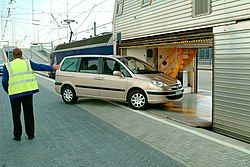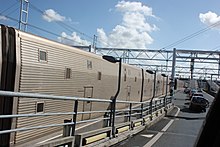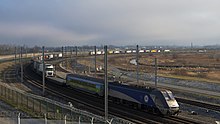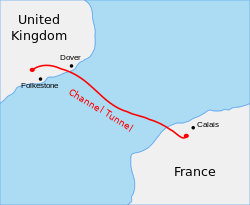LeShuttle
 | |||
| Overview | |||
|---|---|---|---|
| Main station(s) |
| ||
| Fleet size |
| ||
| Stations called at | 2 | ||
| Parent company | Getlink | ||
| Reporting mark | ET | ||
| Other | |||
| Website | leshuttle | ||
| |||
LeShuttle[1] (formerly Eurotunnel Le Shuttle and also known as The Shuttle) is a railway shuttle service between Calais in France and Folkestone in the United Kingdom. It conveys road vehicles (including cars, bicycles and motorcycles) and passengers (including some animals) by rail through the Channel Tunnel. Freight vehicles are carried in separate shuttle trains hauled by the same locomotives, that also contain a passenger carriage, known as the Club Car.
The service is owned and operated by Getlink, the owner of the Channel Tunnel.
Operation
[edit]Both terminals are provided with vehicle check-in booths and juxtaposed controls (where pre-boarding immigration and customs checks are carried out by the French Border Police, French Customs and the UK Border Force at the same location), a large convenience outlet, long loading platforms and a loop of track. On arrival at the terminal, having booked beforehand or not, vehicles can check in (in separate freight/passenger booths). If the vehicle is too early for its booked train, the passengers may visit the terminal building with cafés and duty-free shopping, driving onto the train once called to do so.
En route to the train, passengers travel through the juxtaposed control area and are led into queues to drive onto the train. Once boarding is complete, safety announcements are played through the public address system and the train departs once the loading wagons are prepared for departure. After a train emerges from the tunnel, about 22 minutes later, it travels around the loop and stops at the terminal platform. It is then unloaded and reloaded with a new set of vehicles just over half an hour. Meanwhile, for passengers, they drive their vehicles off of the train and onto the French A16 autoroute or the British M20 motorway with no further controls. During busier periods the complete journey takes at least 1 hour and 30 minutes between the highways, with the platform-to-platform crossing being 35 minutes long. During quieter periods it may be possible to board an earlier-departing train resulting in a complete journey time between the highways of just over an hour.
The rail loop at Folkestone runs clockwise and is mostly in a cut-and-cover tunnel, whereas the loop at Coquelles goes anti-clockwise and out in the open. This evens the wear on the wheels of the shuttle locomotives and carriages, as each set (left or right) spends only half the time at the outer edge of the line traversing the curves.
Depending on traffic, each hour there are between two and four passenger vehicle shuttle train departures and between four and seven heavy goods vehicle shuttle departures.
Carriages
[edit]

A LeShuttle train is about 775 metres (2,540 ft) long and made from stainless steel.[2] The carriages used for the shuttle have a larger loading gauge than either British or French railways. As a result, they cannot travel outside the tunnel and its two terminals onto the national railways.
Passenger vehicle shuttle trains
[edit]LeShuttle has nine car shuttle trains for passenger vehicles, each with a locomotive at each end and a series of fully enclosed vehicle carrying wagons (train cars) in between, each 26 metres (85 ft 4 in) long.[3] The train is made up of two sections coupled together. One section is single deck and the other is double deck. Each section has a total of 14 wagons, 12 which carry vehicles plus a loading/unloading wagon on either side. Between cars are fire resistant doors that open during vehicle loading and close for travel through the tunnel. Loading/unloading wagons also have plates that allow vehicles to travel between the train carriage and the platform.
Double-deck loader wagons also have a ramp that allows vehicles to access the upper level. Vehicles under 1.85 metres (6 ft 1 in) in height are typically loaded onto the double-deck portion of the shuttle. Higher or longer vehicles, such as motorhomes, coaches and vehicles pulling a trailer are loaded onto the single deck portion of the shuttle. Ordinary cars can also be placed in the unused portion of single deck wagons. Eurotunnel will occasionally run the double-deck carriages at "half full", closing the top deck to reduce staffing costs.
Once boarded, drivers and passengers can exit their vehicles to stretch their legs or use the toilets, but there are no onboard services. Toilets are provided in every third carriage in the double-deck section and in the loading carriages' single-deck section. Passengers are advised not to walk between parked vehicles in areas that are not designated crossing areas, because the gradients in the tunnel (16 km (9.9 mi) of continuous slope at 1.1% on the English side)[4] mean there is a dangerous possibility that vehicles could roll back and/or forward if the drivers forget to turn on the parking brake.
Freight vehicle shuttle trains
[edit]
Lorries (trucks) are carried on HGV (heavy goods vehicles) shuttles separate from passenger vehicle shuttles. LeShuttle has a fleet of 15 HGV shuttle trains which each have a locomotive on each end, 31 or 32 mostly open vehicle-carrying wagons (train cars), three loading/unloading wagons (one on either side of the train and one in the middle), and a single passenger carriage called the "club car" which is 25.72 m (84 ft 5 in) long. [5] The vehicle-carrying wagons are 20 m (65 ft 7 in) long[5] and have a metal frame that places a metal roof over the cab of the lorry (the most likely location for a fire to ignite), but the rest of the vehicle is not enclosed.
Drivers load their own lorries onto the trains, and once they are in place and secured with wheel chocks they are taken to the club car at the front of the train by minibus. The club car offers free Wi-Fi, toilets and vending machines with drinks and snacks. At the end of the journey, drivers are taken back to their vehicle so they can drive off the train to continue their journey.
Control centres
[edit]Rail and road traffic control centres are operated 24/7.
The overall management of the Channel Tunnel transport system is carried out from a railway control centre, the RCC. There are two control centres, one at each terminal, and each is capable of taking control of the system. The RCC manages all rail traffic (shuttles and trains) circulating on the Channel Tunnel infrastructure, including in the terminal areas.
The system consists of two parts, RTM (Rail Traffic Management) manages all rail traffic in the tunnels and in the terminal areas, and the EMS (Engineering Management System), which manages fixed equipment such as ventilation, lighting, feeding electricity to the catenary wires.[6]
The Road Traffic Control Centres (TCC) are responsible for managing the movement of vehicles for Passenger and Freight services as they circulate around each terminal, presenting tolls, moving through border controls, boarding trains and exiting trains onto motorways (the A16 in France and M20 in the UK).
Safety
[edit]Safety regulations require two locomotives for all shuttle trains through the tunnel, one at the front and one at the back, and both must be staffed so that the train can be reversed out in case of a blockage. On shuttle trains, two Class 9 locomotives handle a single shuttle train. Each locomotive is capable of hauling the train on its own if its partner fails. Should both locomotives fail, another train with two fully functioning locomotives has sufficient power to move both its own load and the disabled train through the tunnel. Diesel locomotives are also on hand at both terminals in case they are needed to help a train out.
There are also attendants in shuttle trains that manage the vehicles, loading and interior functions. On freight vehicle shuttles, the attendants ride in the passenger carriage at the front of the train with the truck drivers; in the passenger vehicle shuttles, they patrol the train. The trains are also long enough so that no matter where in the tunnel, the length of the train spans two evacuation doors into the service tunnel adjacent to the rail tunnels. Passenger carriages are pressurised and sealed off with fireproof doors. These doors are closed once all vehicles are loaded. They include smaller pedestrian doors that may be opened when the train is in motion to move from one carriage to the next but then close automatically.
Eurotunnel has been criticised for failing to implement measures to prevent or extinguish fires in the open-framed large-goods-vehicle-carrying wagons; recommendations made by the Fire Brigade Union in 1996 following a fire in the Channel Tunnel – that closed wagons should be used to prevent the spread of fire – were not acted upon.[7][8]
Newer safety regulations have been tightened and relaxed. For one, trains are no longer required to have a locomotive at each end, just a driving cab at each end, as a rescue locomotive could assist a stricken train and the train does not need to split into sections. On the other hand, to stop the spread of fires, the formerly full lattice steel freight shuttle wagons now only cover the cab, and checks are carried out at each end of the tunnel to stop the risk of another fire happening in the future.
References
[edit]- ^ "Eurotunnel le Shuttle undergoes biggest rebrand in 30 years". 12 May 2023.
- ^ "The Channel Tunnel - interesting facts". Eurotunnel Le Shuttle.
- ^ Haydock, David (2020). Channel Tunnel: 25 years of experience. Platform 5. pp. 20–21. ISBN 978-1-909431-77-5.
- ^ "Rolling stock - Eurotunnel". Getlink. Retrieved 6 November 2020.
- ^ a b Haydock, David (2020). Channel Tunnel: 25 Years of Experience. Platform 5. pp. 26–27. ISBN 978-1-909431-77-5.
- ^ "The Channel Tunnel - Eurotunnel". Getlink. Retrieved 3 July 2020.
- ^ Owen, Ed (18 September 2008). "Channel Tunnel fire made worse by open wagons". New Civil Engineer. London: Ascential. ISSN 0307-7683. Retrieved 14 January 2010.
- ^ Jones, Sam (18 September 2008). "Eurotunnel did not follow safety recommendations made after previous blazes". The Guardian. London. eISSN 1756-3224. ISSN 0261-3077. Retrieved 14 January 2010.

